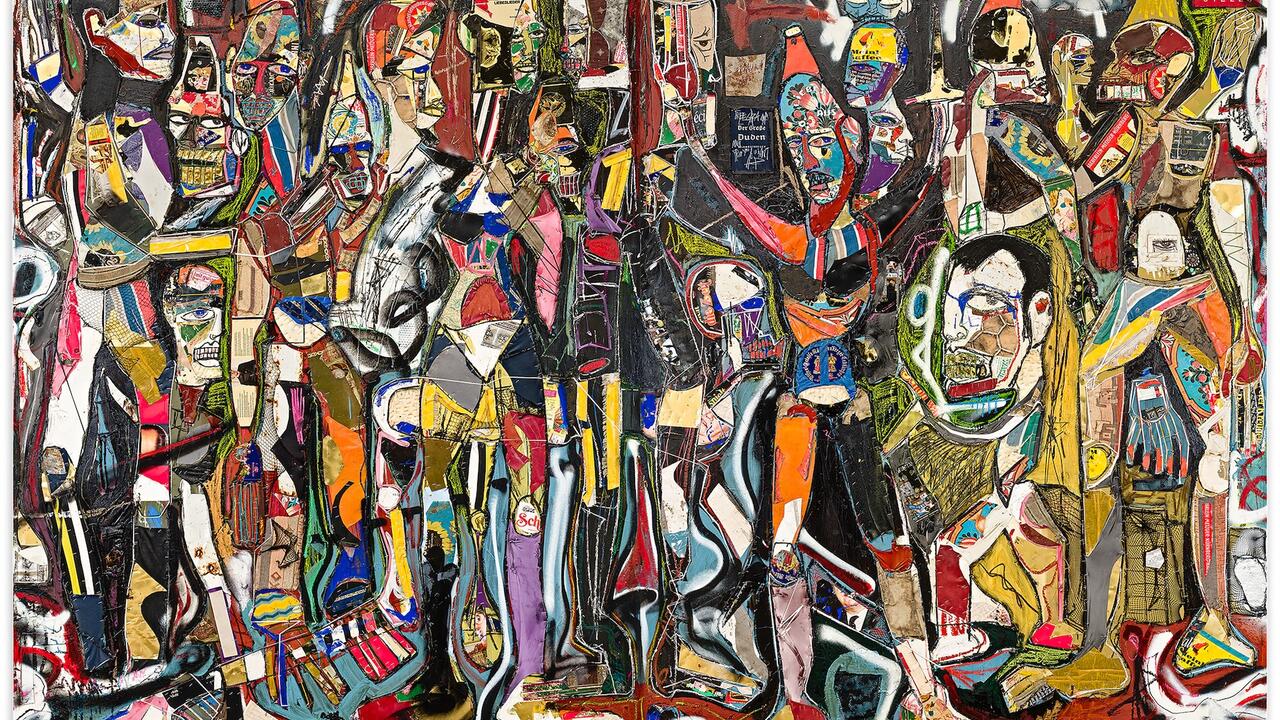8th Gwangju Biennale
‘10,000 Lives’ was a fascinating examination of the role of photography in contemporary culture
‘10,000 Lives’ was a fascinating examination of the role of photography in contemporary culture

We ask a lot of biennials – so much, perhaps, that it seems impossible for any curator to fulfil all the hopes we heap upon them. Having recently visited disappointing biennials in Moscow and Sharjah, I was beginning to think that the current models are just too sprawling and ambitious to ever be successful; writing continuously negative reviews was getting depressing. So it’s no overstatement to say that the 8th Gwangju Biennale, ‘10,000 Lives’, curated by Massimiliano Gioni, restored my faith in what a biennial can be. Gioni proved what massive group shows can achieve if the curating is both smart and simple, if works are organized in complementary groups that elevate individual pieces, and if it makes sense that they are in a specific city at a certain point in time. This all sounds obvious, but it was the first time in a long time that I had seen it done successfully.
Gioni described the Biennale as both a requiem for photography and an examination of ‘our obsession with images’. This relatively loose theme allowed for many sub-themes to emerge, in works dating from 1901 to 2010 by 134 artists. Though Gioni’s concept was less didactic or polemical than the biennial themes we’ve become accustomed to, he dictated the route through the exhibition that led through the two large buildings of the main hall and a group of neighbouring venues. The first rooms contained works that focused attention on who is holding the camera and who’s standing on the other side. Arnoud Holleman’s video Untitled (Staphorst) (2003) comprises appropriated black and white archival footage of women from a Dutch fundamentalist Protestant community in the 1960s. The women shield their faces; the film is slowed down so we can see them duck away from the camera’s gaze – and ours. Our desire to see and observe, whether for personal or ethnographic purposes, is never innocent, and portraits, no matter how seemingly benign, can’t help but tell this story.

Along with a staggering amount of major historical works and collections – including Fischli/Weiss’ photographic display, Visible World (1986–2001), and 3,000 of collector Ydessa Hendeles’ archival photographs of teddy bears dating from the first half of the 20th century (Partners [The Teddy Bear Project], 2001–3), Gioni also introduced the idiosyncratic sources of his ideas through objects less obviously considered works of art. These included Untitled (Marilyn Shows What Death Looks Like), a 2010 print of Andre de Dienes’ 1946 photograph of Marilyn Monroe that was snapped during a fashion shoot, just as the young actress apparently playfully threw a towel over her head. The resulting image suggests something more ominous: Monroe shields herself from both camera and viewer. Next to Holleman’s footage, it becomes even more affecting. Both works essentially depict women refusing to yield to the camera’s objectifying gaze.
Gioni built upon the theme of defining one’s self-image in the rooms that followed, including one dedicated to E.J. Bellocq’s ‘Storyville Portraits’ – photographs of New Orleans prostitutes from the early 20th century. Some of the naked women wear masquerade masks, while others have mysteriously had their faces blacked out or violently scratched off. Displayed close to a hyper-realist painting by Franz Gertsch (Self Portrait, 1980), these humbly-scaled images began to weave an art-historical thread through the show – one in which women struggle to define images of themselves, while men control their own representation. But Gioni explored how this condition was effectively inverted, a few rooms later, where Walker Evans’ photographs faced Sherrie Levine’s appropriations of them (‘After Walker Evans’, 1981), alongside Sturtevant’s 1990 copies of Andy Warhol’s ‘Flowers’ installed next to the 1964 originals.
Another strong curatorial sequence involved works that deal with the camera’s ability to see what the human eye cannot. The idea was introduced with Eliot Porter’s exquisite colour dye-transfer prints of birds caught in flight, made using technology he invented in the 1940s. But the mood quickly shifted: alongside Porter’s works were experimental photographs from the same era by Harold Edgerton, whose stroboscopic technology captured now-iconic images of a bullet and droplets of milk. Also shown here was Edgerton’s lesser-known use of the same technology to capture nuclear explosions for the US Army in 1947. At the time, Edgerton’s device was the fastest camera in the world and the atomic bomb was perceived by some as the ultimate symbol of American advancement – here, the two technologies fused uncomfortably.

This kind of dubiously employed ‘technologically-assisted sight’ resonates in Harun Farocki’s Immersion (2009), a two-channel video documenting an experiment with new technology to help Iraq War veterans recover from post-traumatic stress disorder by allowing their experiences to be visualized through computer animation. As the ‘test subject’ is coaxed by a therapist to describe seeing his fellow soldier killed in a Baghdad marketplace, the events are recreated on the neighbouring screen, in crude videogame-like graphics. Not unlike the effect of Edgerton’s images, we have to ask ourselves how useful technology can be in aiding our sight, when it can open up visions that we didn’t bargain for in the blind pursuit of progress.
Another section of the Biennale explored the ways in which images are employed as memorials or, rather, as woefully inadequate substitutes or ideologically instrumentalized replacements for people who are no longer with us. This was particularly powerful in the juxtaposition of two works about iconic political figures who became modern-day martyrs. In 1968, photojournalist Paul Fusco was commissioned to document the journey of Robert F. Kennedy’s coffin from New York to his burial in Arlington, Virginia. Fusco took a series of pictures from the window of the train transporting Kennedy’s body. His photos of farmers, gawking families, nuns and schoolgirls, standing reverently by the train tracks offers a better substitute of the life that’s missing than any picture of the coffin itself.
In a neighbouring room, Leandro Katz’ El Día Que Me Quieras (The Day You’ll Love Me, 1997) is a remarkable documentary about the photojournalist Freddy Alborta, who took photographs of Che Guevara after he was executed: his body tilted upright on a slab surrounded by generals and reporters, his face washed and his eyes open, Guevara looks uncannily Christ-like. The film shows what took place outside the frame: ignored on the floor lay two other executed guerrillas. The work confirms the photojournalist’s role in shaping history, memory and remembrance, and how quickly a single image can become a mythological stand-in for a human being.
As well as investigating the power of iconic images, ‘10,000 Lives’ also dealt with the effect of taxonomic collections of portraits. The most controversial inclusion of these was a selection of photographs documenting some of the 14,000 people tortured and killed in Cambodia (‘Tuol Sleng Prison Photos’, 1975–9/2010). In the photographs, which were used as records, the prisoners are still alive. Each one stands against a blank background, wearing a number. The images are striking both for how willingly some of the subjects appear to submit to the camera, but also for how defiant some of their gazes are. It’s eerie, too, how many tenets these images share with conceptual photography – seriality, uniformity and rigidity: the same ones that can be used to make people into objects, and to dehumanize them.
The only off note in the show was Gioni’s ‘unauthorized, partial reconstruction and unannounced tribute’ to Mike Kelley’s 1993 exhibition ‘The Uncanny’. This collection of mannequins and Wunderkammer-like artefacts felt like a sideshow; it was as if Gioni had envisioned it as an autonomous exhibition but took the opportunity to insert it into the Biennale.
Gioni successfully imported several massive archives for the show, and their effects felt both epic and – like all meticulous records of the everyday – banal. The larger question here seemed to be was: do artists choose to place their faith in the power of images, or do they choose to strip it away? A work such as Hans-Peter Feldmann’s collection of newspaper front-pages from around the world on 12 September 2001 (9/12 Front Page, 2001) can be read two ways: do these pictures symbolize something powerful, or does their ubiquity render them powerless?
The issue of the faith we place in images converged in the Gwangju Museum of Art, where Gioni paired works by Dieter Roth and Andy Warhol. Recovering from alcoholism and close to death Roth’s Solo Scenes (1997–8) is a 128-channel video installation of the artist in his studio, at home, sketching and cursing. Watching the old man pottering around, I sensed he was giving a defiant finger to contemporary image culture. But Roth’s sardonic work is especially touching when paired with a rare glimpse into one of Warhol’s ‘Time Capsules’ (1974–87). Simply labelled ‘–27’, it was dedicated to his mother. Its contents, emptied out and displayed here, include her dresses, scarves and hats hanging next to vitrines filled with her letters, cards and diaries. Roth’s and Warhol’s deeply personal collections of images both, in some way, try to defer an artist’s disappearance or a person’s death, and in this way they sum up Gioni’s magnum opus of an exhibition. Somewhere between the video screens and the treasure box full of memorabilia, is the ambivalent truth about images: that they can mean everything and nothing at the same time.





















